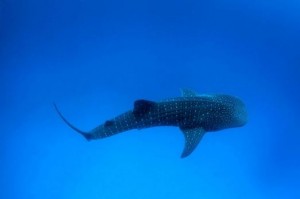They are beloved by scuba divers and are considered a bucket-list experience, even though the encounters are usually snorkel-only ones.
But despite knowing some things about Rhincodon typus (including these fun facts), scientists are still in the dark about many critical aspects of the whale sharks’ lives, including global population.
This information is crucial because they are listed as an endangered species by the International Union for Conservation of Nature. Researchers realized that in order to get a more accurate fix on whale shark population numbers, they had to figure out a way to identify them.
Like the distinctive flukes on some whale species and the spots on the underside of manta rays, which scientists use like are so distinctive that researchers use them like fingerprints to identify individuals, whale sharks also have unique patterns of spots that can be used to tell them apart. So, researchers began depending on various citizen-scientist programs, enlisting scuba divers and snorkelers to submit pictures of whale sharks, along with geographic locations and dates.
The identification process depends on a computer code developed by NASA for use in the Hubble Space Telescope to identify star patterns in astronomical images.
If you’re old enough to remember the launch of the telescope in 1990, you know that NASA realized it was seriously flawed — its optical system focused about as well as the nearsighted cartoon character Mr. Magoo. Hubble — and NASA — became the butt of many jokes at the time. But since then, the telescope has transformed from cosmic joke to cosmic wonder, and is responsible for some of the most breathtaking images taken in space.
The astronomical algorithm used in the telescope was developed by E. J. Groth in the 1980s. In Hubble, it recognizes what part of the sky is contained in an image by comparing the pattern of stars to standard star charts.
Shark researchers adapted this algorithm to identify whale sharks by their spots. (Interestingly, the Javanese name for the whale shark, geger lintang, means “stars in the back.”) Now you can upload your whale shark photos into an online database called Wildbook for Whale Sharks. The site contains nearly 43,000 whale shark sightings and by using the algorithm, researchers have identified more than 8,700 individual sharks. Wildbook uses photographs of the skin patterning behind the gills of each shark, and any scars, to distinguish between individual animals.
More than 5,000 citizen scientists are contributing to the Wildbook project. When photographing a whale shark, it’s important to focus on the pattern of spots behind the gills on the left or right sides — this is its “fingerprint.” Wildbook researchers use an algorithm (or manual comparison) to obtain a ranked selection of possible matches. They then visually confirm a match to an existing whale shark in the database, or create a new individual profile.
“Wildbook for Whale Sharks has pioneered the way for a new generation of global scale, collaborative wildlife projects that blend citizen science and computer vision to help researchers get bigger and more detailed pictures of some of the world’s most mysterious species,” says Jason Holmberg, Information Architect for Wildbook.
The Hubble Space Telescope is projected by NASA to be able to survive until 2020 and possibly even later. We hope whale sharks survive for far longer.
Source: sport diver










